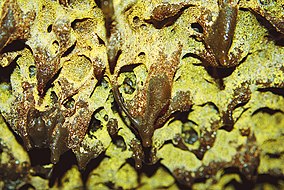Lava Beds National Monument
| Lava Beds National Monument | |
|---|---|
|
IUCN category V (protected landscape/seascape)
|
|

Lavacicles in Golden Dome Cave
|
|
| Location | Siskiyou and Modoc counties, California, USA |
| Nearest city | Tulelake, California |
| Coordinates | 41°42′50″N 121°30′30″W / 41.71389°N 121.50833°WCoordinates: 41°42′50″N 121°30′30″W / 41.71389°N 121.50833°W |
| Area | 46,692 acres (188.96 km2) |
| Established | November 21, 1925 |
| Visitors | 124,113 (in 2011) |
| Governing body | National Park Service |
| Website | |
|
Lava Beds National Monument Archeological District
|
|
| NRHP Reference # | 75002182 |
| Added to NRHP | 1991 |
Lava Beds National Monument is located in northeastern California, in Siskiyou and Modoc counties. The Monument lies on the northeastern flank of the Medicine Lake Volcano, and has the largest total area covered by a volcano in the Cascade Range.
The region in and around Lava Beds Monument lies at the junction of the Sierra-Klamath, Cascade, and the Great Basin physiographic provinces. The Monument was established as a United States National Monument on November 21, 1925, and includes more than 46,000 acres (190 km2).
Lava Beds National Monument has numerous lava tube caves, with twenty-five having marked entrances and developed trails for public access and exploration. The monument also offers trails through the high Great Basin xeric shrubland desert landscape and the volcanic field. 1872–1873, this area was the site of the Modoc War, with a band led by Kintpuash (also known as Captain Jack). The area of Captain Jack's Stronghold was named in his honor.
Lava Beds National Monument is geologically outstanding because of its great variety of "textbook" volcanic formations, including lava tube caves, fumaroles, cinder cones, spatter cones, pit craters, hornitos, maars, lava flows, and volcanic fields.
...
Wikipedia


